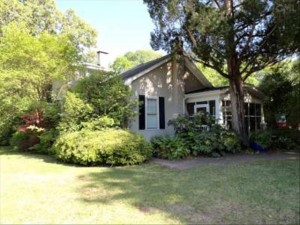 There are many good reasons to consider purchasing an older home, i.e., one built prior to 1980. Typically, these homes offer more square footage per dollar, more character and higher quality construction. However, these homes include mature landscaping that can pose some challenges for the new home owner. The current landscape of an older home is far different from what was installed years ago. For example, the trees and shrubs are much bigger; there is more shade and less sunlight, and higher root density under shrub beds and turf grass areas.
There are many good reasons to consider purchasing an older home, i.e., one built prior to 1980. Typically, these homes offer more square footage per dollar, more character and higher quality construction. However, these homes include mature landscaping that can pose some challenges for the new home owner. The current landscape of an older home is far different from what was installed years ago. For example, the trees and shrubs are much bigger; there is more shade and less sunlight, and higher root density under shrub beds and turf grass areas.
New homeowners of an older home with mature landscaping should consider the following steps to achieve the yard of their dreams.
Owner Profiling: Ask yourself a series of profiling questions. Do I entertain and spend a lot of time outdoors? If so, how many guests at one time? How many members are in my family? How long do I plan to live at this home? What are my goals for this landscape?
Site Analysis/Inventory: Note any problems including drainage issues, soil compaction, poor turf color and density, diseased trees and shrubs, adverse topography, and limited parking. Photograph the house from the approach angle from the street. Photograph the house’s center axis from across the street. These photographs will help in designing the new landscape.
Take inventory of existing plant material. Decide what plants are to be removed and those to be incorporated into the new design. Record the diameter of those to be saved.
It is very important to analyze the turf, the soil and the environment that it is growing in, regardless of the condition of the turf. Any problems should be ameliorated with proper treatment.
Regarding turf, there are four options to consider, either singly or in combination:
1. Invigorate existing turf.
2. Entirely replace the sod with new sod.
3. Patch in new sod.
4. Enlarge mulched areas where turf will not grow.
It is more economical to replace the entire lawn when 50 percent or more of the turf is affected. All biotic diseases and/or abiotic disorders should be addressed before any new sod is installed. There are three tests that should be administered:
1. Soil analysis for nutrient study and soil pH.
2. Pathogenic nematode count.
3. Plant problem clinic sample for pathogenic microorganisms and harmful insects.
Samples can be submitted to your local Clemson University Extension Office. The total cost for these services is $26.00 as of this writing.
Budget: Determine what you can spend. Do you have a lump sum to spend now, or do you want to set a dollar amount each year to generally improve the landscaping and install the improvements area by area each year. What areas are priorities?
 Design: A landscape design can now be developed using owner profiling, site analysis and budget. The design can be produced either by a professional landscape designer or yourself. To help the DIYer, consider taking two courses at Midlands Technical College: Landscape Design and Landscape Construction.
Design: A landscape design can now be developed using owner profiling, site analysis and budget. The design can be produced either by a professional landscape designer or yourself. To help the DIYer, consider taking two courses at Midlands Technical College: Landscape Design and Landscape Construction.
Design Considerations for Mature Yards: Many older yards have too much shade. This problem can be solved by either limbing-up or removing trees, thus improving air circulation and allowing sunlight to shine on the turf grass and lower canopy shrubs. Wooden decks are preferred in high root density over patios. The soil excavation to install paver patios and walkways destroy root systems of prized mature trees.
Landscape Installation: We now come to a divide in the road. Do you provide the elbow grease or hire a contractor? If a professional landscape designer has produced the design, you may be armed with some of his or her information to communicate with a contractor to achieve exactly what you want for the design. If you take the above landscaping courses as mentioned above, you will be armed with information to accomplish the desired results. If contractors know that you have knowledge of design and installation, they will do a better job and at a reasonable price.




